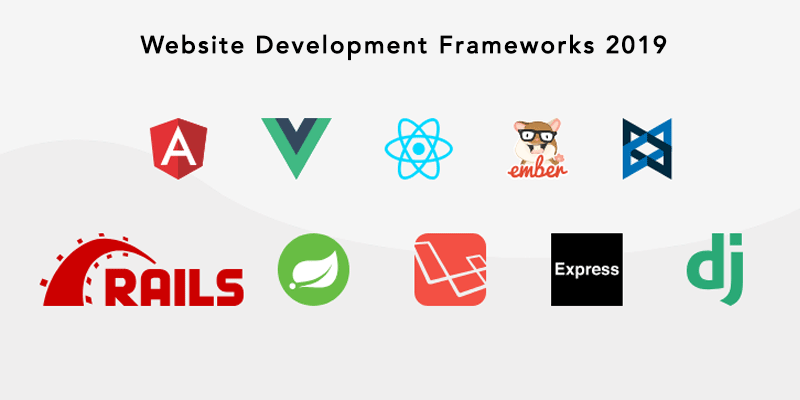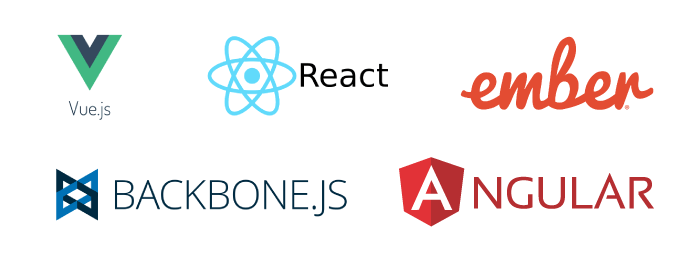
Frameworks became an important part of web development because the standards of net applications area unit perpetually rising, thus will the quality of the technology required. It’s fully unreasonable to reinvent the wheel for such complicated technologies -assuming that you just will reinvent all that.
That’s why victimization frameworks supported by thousands of developers around the sector can be a really smart approach for constructing rich and interactive web programs. an online app features a backend (server-aspect) and a frontend (customer aspect) for this reason we will scrutinize every best Backend framework but as frontend frameworks. here is going the list of excellent web development frameworks in 2019.
Backend Frameworks
From RESTful APIs to complete MVC frameworks, here are some of the most powerful backend frameworks in 2019 that you might be interested in.
Express
Thanks to the skyrocketing popularity of Node.js, Express is quickly changing into one of the foremost trending frameworks today. it’s utilized by Accenture, IBM, and Uber, and lots of alternative firms, and it’s additionally getting used in different frameworks like Kraken, Sails, and Loopback.
Express prides itself as a token, quick and unopinionated framework. It provides some core framework functionalities while not obscuring the options of Node and leverages the powerful performance of the asynchronous Node.js. It’s conjointly quite versatile and supports full applications moreover as REST API. maybe the most important downside of categorical is that the indisputable fact that there’s no outlined method of doing things, at least for beginners.
Django
Django is a Model-View-Template framework that uses Python for web development. It’s used by some of the big names such as Google, Youtube, and Instagram. Django boasts its batteries-included feature, which is the bunch of features such as authentication and messaging that Django comes bundled with. It follows the Convention Over Configuration pattern and the DRY pattern as well.
Security in Django is a serious topic and Django either provides techniques and tools for developers to build a secure website, or implements the security features in the framework itself like preventing code execution in the template layer. Here is our detailed post on Django:
Rails
Rail is a Model-View-Controller framework that uses Ruby and it’s a popular framework that is loved by many developers. Rails are used by Airbnb, GitHub, Hulu, and Shopify. Rail is a beginner-friendly framework, and although the fact that there’s a lot of magic behind the curtains in this framework is debated over pros and cons, it helps beginners get started with web development quite easily.
There are many useful gems for rails, which are library-like dependencies that extend the functionalities of your application and helps you develop an app in Android and IOS even faster and more efficiently. The Rails community is quite strong and friendly, and there are many tutorials, screencasts, and resources that can help you become a rails expert in no time.
The main disadvantage of rails lies in the fact that they take quite some effort to deploy and run in a production environment, and the learning curve of rails becomes really steep once you dive deeper into the framework to unravel the magic behind it.
Laravel
Laravel is a Model-View-Controller framework that uses PHP, which is one of the most famous languages of the web. It’s relatively young compared to other frameworks on this list.
Laravel Web Development comes with API support out of the box and it also possesses a decent amount of packages that could extend its reach. Laracasts is a screencasts tutorials website with over a thousand videos on PHP, Laravel, and frontend technologies in the Laravel ecosystem that could be considered to be a beginner’s heaven. In terms of performance, however, Laravel doesn’t compare to Django or Express, which might be a drawback for heavy projects.
Spring
Spring is a Model-View-Controller framework that uses Java, the all-time popular language. It’s used by websites like Wix, TicketMaster, and BillGuard. Spring possesses a lot of sister projects that boost its performance and let you scale your business easily. The fact that it uses Java, a strongly typed language, is a serious pro for many web developers. The learning curve might be quite steep tho, especially if you don’t know Java.
Frontend Javascript Frameworks

Angular
Angular is a front-end framework that specializes in building rich Single-Page applications. It’s a very rich framework able to build complete client-side applications and there’s so much to do and learn in Angular. Angular 1.x used Javascript, but later releases adopted Typescript, which is a superset of Javascript. Angular’s main cons are its size compared to other frameworks, and the fact it’s not SEO friendly by nature, though it can be SEO optimized. Angular was developed by Google, and it’s used by Google, Microsoft, and Paypal. Here is our detailed post on Angular.
React
React is not a framework, it’s a frontend library, but many developers think about it as a framework and it’s typically compared in that context. ReactJS Web Development was the first to adopt the component-based design that Angular and Vue and lots of different frameworks began to adopt in a while. React’s virtual dom makes the dom-manipulation a lot quicker and it’s quite straightforward to choose up, particularly because of its JSX syntax. React might be used server-side or consumer-side. it had been developed and maintained by Facebook and it’s utilized by Facebook and Instagram.
Vue
Vue.js is the new rising star, it started as an individual project and quickly grew into becoming one of the most trending JS frameworks out there. There are many cool things about Vue, first, it’s a progressive framework, which means that if you have an existing project, you can adopt Vue for one portion of the project and everything would work just fine. Second, it also brings along the component architecture to play, and the Vue ecosystem can help you build complete frontend applications. Some people are wary of using Vue since it’s not supported by a big company like Facebook or Google, but that’s quickly changing as big names are starting to invest in Vue.
Ember
Ember was named the best Javascript framework back in 2015. Today, the Ember community is huge and it’s ever-expanding, with new features and releases being added regularly. Ember possesses the two-way data binding that Angular boasts and it comes with a lot of features and components that you can use out of the box. It’s being used by Google, Microsoft, Heroku, and Netflix. Ember revolves around the developer’s productivity and attempts to maximize it by either eliminating the need for time-wasting activities or adopting some JS best practices in its core design.
Backbone
Backbone is a particularly lightweight frontend framework that’s appropriate for building rich Single-Page applications. It follows an MV* pattern and partially implements the MVC style. Backbone solely has one core dependency which is the Underscore library, and it has a rich system, that when added to hair and puppet, can enable you to make complete client-side applications.
Final Word
I hope you discover our list of hottest web frameworks helpful. Don’t be afraid to select up a framework and begin performing on it, it’ll definitely offer you an insight into how things are done and you’ll realize many similarities between frameworks, even across totally different languages within the same class. keep in mind that great companies are forever migrating and attempting new stuff all the time, therefore there’s no such factor as a dead finish.

